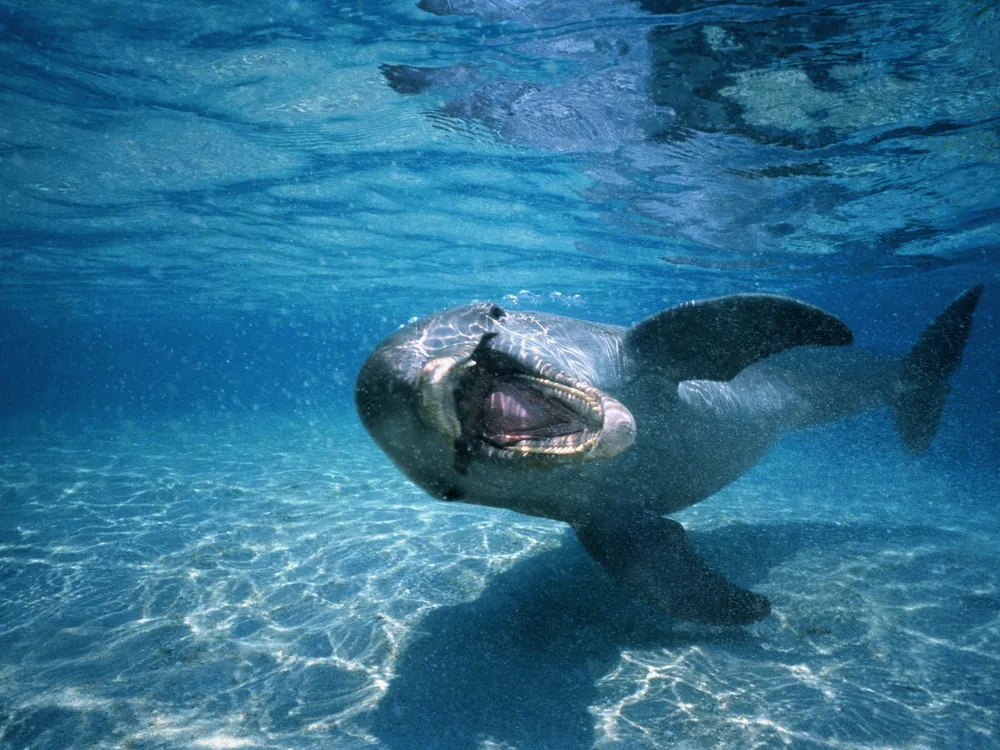A Dolphin Keeps Biting People in Japan. Researchers Think It’s Just Lonely
A series of dolphin attacks in Wakasa Bay is believed to be the doing of a lone male bottlenose dolphin looking for friends or a mate—but finding only humans

Beachgoers can already have a lot to worry about, with sharks and stinging jellyfish potentially lurking beneath the waves. But in Japan’s Wakasa Bay, swimmers are on high alert for yet another underwater threat: dolphins—or, according to some theories, a lone male bottlenose dolphin who seemingly likes to bite and wrestle.
The risk isn’t new: In 2022, a man told the Mainichi’s Yoko Kunimoto that a dolphin appeared next to him suddenly, bit him and then forced itself on top of him. “I panicked, but I was saved when someone nearby drove it away,” he added.
Twenty-one injuries from dolphin attacks were reported in the area that year. In 2023, people reported ten. So far this year, at least 18 people have been injured by dolphins in Japan’s Fukui Prefecture, sustaining bites or broken bones. “Who knows the reason? We have to ask the dolphins,” Hiromu Nohara, a town official in Mihama on Wakasa Bay, tells the New York Times’ Hisako Ueno and Yan Zhuang.
Some observers suggest the incidents can all be tied to the same dolphin, based on wound scars on its tail fin, which can be used to identify an individual, reports BBC News’ Kelly Ng. The individual seems to have become isolated from its pod.
Swimmers in Wakasa Bay are wondering why the dolphin may be targeting them. For now, experts who study the marine mammals can only offer some ideas. “Bottlenose dolphins are highly social animals, and this sociality can be expressed in very physical ways,” Simon Allen, a biologist with the Shark Bay Dolphin Research project, says to BBC News.
But exactly what type of sociality the animal may be expressing remains a mystery.
Tadamichi Morisaka, a dolphin ecologist at Mie University in Japan, tells Nature News’ Anna Ikarashi that friendship could be the main motivation. In their pods, male bottlenose dolphins form tight, affectionate and lifelong partnerships, which they maintain in part through physical or sexual touch.
“Hanging out in pairs gives them better access to females, because two is stronger than one,” Morisaka tells Nature News. “Gentle biting is one of these pro-social behaviors. So, the dolphin in Fukui is acting like he’s playing with a male pairmate, but with humans instead.”

The dolphin’s aims could also be sexually motivated. Some researchers think the dolphin could be trying to engage in mating behaviors. Even if no harm is intended, the dolphin’s size and strength make this dangerous. Putu Mustika, a marine researcher at James Cook University in Australia, tells the New York Times that “dolphins, when they are mating, can be very wild.” The individual in Wakasa Bay might just be a “horny, lonely dolphin,” she adds.
Yet another possibility could be that the dolphin perceives humans as a threat and is acting in self-defense. But Morisaka tells Nature News: “If he really wanted to attack, he could have come tackling at full force and chomped down. But he’s keeping the biting gentle for dolphin standards, so it’s probably a friendly gesture rather than a full-on attempt to attack.”
Despite their gentle reputation, dolphins can act aggressively when they think it’s necessary. Researchers have observed dolphins successfully defending themselves from and sometimes even killing tiger sharks. Experts say that if swimmers see a wild dolphin coming close, they should leave the water and watch it from shore.
“People would run away if it were a bear,” Ryoichi Matsubara, the director of Echizen Matsushima Aquarium in Fukui, tells the New York Times. “There is no difference between dolphins and bears in terms of destructive capacity.”